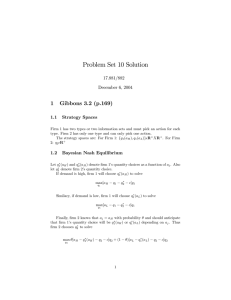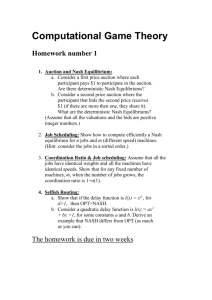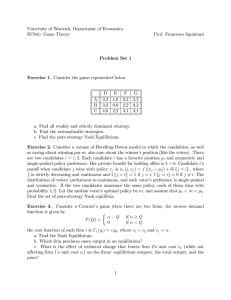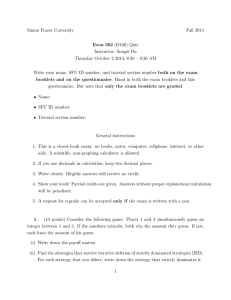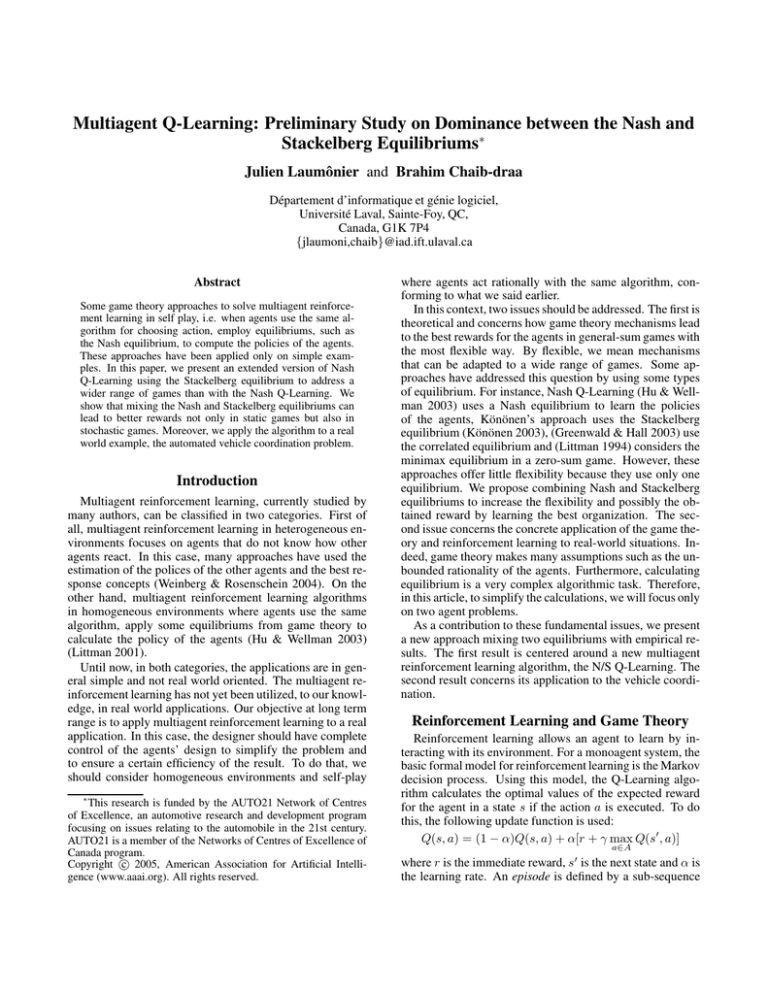
Multiagent Q-Learning: Preliminary Study on Dominance between the Nash and
Stackelberg Equilibriums∗
Julien Laumônier and Brahim Chaib-draa
Département d’informatique et génie logiciel,
Université Laval, Sainte-Foy, QC,
Canada, G1K 7P4
{jlaumoni,chaib}@iad.ift.ulaval.ca
Abstract
Some game theory approaches to solve multiagent reinforcement learning in self play, i.e. when agents use the same algorithm for choosing action, employ equilibriums, such as
the Nash equilibrium, to compute the policies of the agents.
These approaches have been applied only on simple examples. In this paper, we present an extended version of Nash
Q-Learning using the Stackelberg equilibrium to address a
wider range of games than with the Nash Q-Learning. We
show that mixing the Nash and Stackelberg equilibriums can
lead to better rewards not only in static games but also in
stochastic games. Moreover, we apply the algorithm to a real
world example, the automated vehicle coordination problem.
Introduction
Multiagent reinforcement learning, currently studied by
many authors, can be classified in two categories. First of
all, multiagent reinforcement learning in heterogeneous environments focuses on agents that do not know how other
agents react. In this case, many approaches have used the
estimation of the polices of the other agents and the best response concepts (Weinberg & Rosenschein 2004). On the
other hand, multiagent reinforcement learning algorithms
in homogeneous environments where agents use the same
algorithm, apply some equilibriums from game theory to
calculate the policy of the agents (Hu & Wellman 2003)
(Littman 2001).
Until now, in both categories, the applications are in general simple and not real world oriented. The multiagent reinforcement learning has not yet been utilized, to our knowledge, in real world applications. Our objective at long term
range is to apply multiagent reinforcement learning to a real
application. In this case, the designer should have complete
control of the agents’ design to simplify the problem and
to ensure a certain efficiency of the result. To do that, we
should consider homogeneous environments and self-play
∗
This research is funded by the AUTO21 Network of Centres
of Excellence, an automotive research and development program
focusing on issues relating to the automobile in the 21st century.
AUTO21 is a member of the Networks of Centres of Excellence of
Canada program.
c 2005, American Association for Artificial IntelliCopyright gence (www.aaai.org). All rights reserved.
where agents act rationally with the same algorithm, conforming to what we said earlier.
In this context, two issues should be addressed. The first is
theoretical and concerns how game theory mechanisms lead
to the best rewards for the agents in general-sum games with
the most flexible way. By flexible, we mean mechanisms
that can be adapted to a wide range of games. Some approaches have addressed this question by using some types
of equilibrium. For instance, Nash Q-Learning (Hu & Wellman 2003) uses a Nash equilibrium to learn the policies
of the agents, Könönen’s approach uses the Stackelberg
equilibrium (Könönen 2003), (Greenwald & Hall 2003) use
the correlated equilibrium and (Littman 1994) considers the
minimax equilibrium in a zero-sum game. However, these
approaches offer little flexibility because they use only one
equilibrium. We propose combining Nash and Stackelberg
equilibriums to increase the flexibility and possibly the obtained reward by learning the best organization. The second issue concerns the concrete application of the game theory and reinforcement learning to real-world situations. Indeed, game theory makes many assumptions such as the unbounded rationality of the agents. Furthermore, calculating
equilibrium is a very complex algorithmic task. Therefore,
in this article, to simplify the calculations, we will focus only
on two agent problems.
As a contribution to these fundamental issues, we present
a new approach mixing two equilibriums with empirical results. The first result is centered around a new multiagent
reinforcement learning algorithm, the N/S Q-Learning. The
second result concerns its application to the vehicle coordination.
Reinforcement Learning and Game Theory
Reinforcement learning allows an agent to learn by interacting with its environment. For a monoagent system, the
basic formal model for reinforcement learning is the Markov
decision process. Using this model, the Q-Learning algorithm calculates the optimal values of the expected reward
for the agent in a state s if the action a is executed. To do
this, the following update function is used:
Q(s, a) = (1 − α)Q(s, a) + α[r + γ max Q(s0 , a)]
a∈A
where r is the immediate reward, s0 is the next state and α is
the learning rate. An episode is defined by a sub-sequence
of interaction between the agent and its environment.
On the other hand, Game Theory studies formally the
interaction of rational agents. In a one-stage game, each
agent i has to choose an action to maximise its own utility U i (ai , a−i ) which depends on the others’ actions a−i .
An action can be mixed if the agent chooses it with a given
probability and can be pure if it is chosen with probability 1. In game theory, the solution concept is the notion of
equilibrium. The equilibriums are mainly based on the best
response for an agent to other’s actions. Formally, an action
aibr is a best response to actions a−i of the others agents if
U i (aibr , a−i ) ≥ U i (a0i , a−i ) ∀a0i .
The set of best responses to a−i is noted BRi (a−i ).
The Nash equilibrium is the best response for all agents.
Formally, a joint action aN , which regroups the actions for
all agents, is a Nash equilibrium if
∀i, aiN ∈ BRi (a−i )
where aiN is the action of the ith agent in the Nash equilibrium and a−i
N is the actions of other agents at Nash equilibrium.
The Nash equilibrium is not the only best response and
many others can be cited (Correlated, etc.). Among these,
the Stackelberg equilibrium (Basar & Olsder 1999) is a best
response with the existence of a hierarchy between agents.
Some agents are leaders and others are followers. For a two
players game, the leader begins the game by announcing its
action. Then, the follower acts according to the leader’s action. Formally, in a two player game, where agent 1 is the
leader and agent 2 is the follower, an action a1S is a Stackelberg equilibrium for the leader if
min
a2 ∈BR2 (a1S )
U 1 (a1S , a2 ) = max
1
1
min
a ∈A a2 ∈BR2 (a1 )
U 1 (a1 , a2 ).
From this point, the Stackelberg equilibrium will be noted
Sti when agent i is the leader.
The model which combines reinforcement learning and
game theory, is stochastic games (Basar & Olsder 1999).
This model is a tuple < Ag, S, Ai , P, Ri > where
& Wellman 2003). In this approach, the agents choose their
actions by calculating a Nash equilibrium and update the Qvalue with the following function : Qjt+1 (s, a1 , · · · , an ) =
(1 − α)Qjt (s, a1 , · · · , an ) + αt [rtj + γN ashQjt (s0 )], where
N ashQjt (s0 ) is the agent i’s Q-value in state s0 at Nash equilibrium.
The Könönen’s approach (Könönen 2003) has used
the Stackelberg equilibrium to update the Q-values
and chose the agents’ actions.
With agent 1 as
the leader and agent 2 as the follower, the updates are respectively: Q1t+1 (st , a1t , a2t ) = (1 −
1
αt )Q1t (st , a1t , a2t ) + αt [rt+1
+ γmaxQ1t (st+1 , b, T (b))], and
b
2
+
Q2t+1 (st , a1t , a2t ) = (1 − αt )Q2t (st , a1t , a2t ) + αt [rt+1
2
c
γmaxQt (st+1 , g(st+1 , at+1 ), b)] where T (b) is the folb
lower’s action according to the actual leader’s action b.
One can show that the value of the Stackelberg equilibrium for the leader is at least as good as the value for the
Nash equilibrium if the response of the follower is unique
(Basar & Olsder 1999). As well, once the hierarchy between
agents is fixed, none of the agents has an interest in deviating
from the Stackelberg equilibrium. These properties show
that a Stackelberg equilibrium could be a good choice for
computing the agents’ policies. In the next section, we will
show how to combine Nash and Stackelberg approaches to
obtain a better reward with more flexibility.
N/S Q-Learning
As shown in (Littman & Stone 2001), in self-play and in
repeated games1 , two best-response agents can result in suboptimal behaviour. Littman & Stone have shown that some
strategies like Stackelberg or Godfather, which is a generalization of tit-for-tat, may lead to a better reward. Therefore,
we propose to choose between equilibriums during learning. In games with only one state, the interest of choosing
among several equilibriums can be shown by the following
example:
• Ag is the set of agents where card(Ag) = N ,
• S = {s0 , · · · , sM } is the finite set of states where card(S)
= M,
• Ai = {ai0 , · · · , aip } is the finite set of actions for the agent
i,
• P : S × A1 × · · · × AN × S → ∆(S) is the transition
function from current state, agents actions and new state
to probability distribution over state,
• Ri : S × A1 × · · · × AN → R is the immediate reward
function of agent i.
Many approaches utilizing this model, use a Q-Learning
extension by applying equilibrium concept instead of maximum operator for the update of the Q-values and the agents’
actions choice. Among these approaches, one can cite the
Nash Q-Learning for general-sum games where the convergence has been demonstrated with restrictive conditions (Hu
Agent 1
a1
a2
a3
a1
(2,2)
(1,2)
(1,1)
Agent 2
a2
a3
(2,1) (0,1)
(5,3) (0,4)
(4,2) (1,1)
In this game, the Nash equilibrium is (a1 , a1 ) and each
agent receives 2 for reward. The Stackelberg equilibrium
St1 is (a3 , a2 ) and St2 is (a2 , a2 ). We show that St2 is
better for both agents and dominates the other ones. The
dominance equilibrium concept is defined by (Simaan &
Takayama 1977). Formally, an equilibrium E1 dominates
an equilibrium E2 if
U j (a1E1 , a2E1 ) > U j (a1E2 , a2E2 ) ∀j.
Using this dominance definition, three cases are possible:
1. None of the Stackelberg equilibriums (St1 or St2 ) dominates the Nash equilibrium. In this case, the mutual best
response for both agents is the Nash equilibrium.
1
A repeated game is a one-stage game played numerous times.
PSfrag replacements
2. Only one of the Stackelberg equilibriums dominates the
Nash equilibrium. In this case the agents have an interest
in playing the dominant Stackelberg equilibrium.
3. Both Stackelberg equilibriums dominate the Nash equilibrium. In this case, if one of the Stackelberg equilibriums dominates the other one, the agents have an interest
in playing this equilibrium. Otherwise, both agents want
to be either leader or follower. The Nash equilibrium is
the only acceptable solution in this case.
To guarantee the existence in each step, we calculate the
Nash equilibriums in mixed strategy and the Stackelberg
equilibriums in pure strategy. If multiple Nash equilibriums
exist, we choose either the first Nash, the second Nash or the
best Nash as described by (Hu & Wellman 2003).
The N/S Q-Learning, presented by algorithm 1, is based
on the Nash Q-Learning but uses the dominant equilibrium concept to choose the agents’ actions and update
the Q-values. At each instance, each agent chooses the
best equilibrium according to the dominance concept presented earlier. The Q-values are updated by calculating
QEquilibrium(s0), the value at the best equilibrium in the
next state s0 .
Algorithm 1 N/S Q-learning
Initialize :
Q = arbitrary Q-value function.
for all episodes do
Initialize s
repeat
Choose ~a = a1 , . . . , an from s by using the best
equilibrium.
Do actions a1 , . . . , an ,
Observe r1 , . . . , rn and next state s0
for all agent i do
Qi (s, ~a)
=
(1 − α)Qi (s, ~a) + α[r +
γQEquilibrium(s0)]
end for
s = s0
until s is terminal
end for
Experiments 1: Abstract Values
To test the N/S Q-Learning algorithm, we have used an
abstract stochastic game to show how equilibrium choice
can lead to a better reward than with Nash Q-Learning. Each
agent can execute the actions a1 and a2 at each step. The
system can be in 5 different states (s1 , . . . s5 ). Figure 1
shows the state transitions according to the agents’ actions.
For instance, (a1 , a2 ) corresponds to action a1 for the first
agent and a2 for the second agent. The star indicates any
actions. The rewards are given in the state s4 according to
the following table:
Agent 1
a1
a2
Agent 2
a1
a2
(9,6) (11,2)
(8,5) (10,7)
(a1 , a1 )
s1
s2
(∗, ∗)
(a2 , a1 ) ou (a1 , a2 )
(a2 , a2 )
s3
s4
(∗, ∗)
s5
(∗, ∗)
Figure 1: Transitions for the stochastic game.
We have measured the ratio of use equilibriums in each
episode. This ratio is presented in Figure 2 for the N/S QLearning (top) and Nash Q-Learning (Bottom). In the top
figure St2 is mixed with the line y = 0 and, in the bottom figure, St1 and St2 are never used. Notice that, from
the 350th episodes, the use of St1 increases whereas the
Nash equilibrium is obviously always used with the Nash
Q-Learning algorithm. Figure 3 shows that the rewards of
both agents tend toward St1 (a2 , a2 ) rewards. These rewards are greater than the reward obtained by the Nash
Equilibrium. We have tested our algorithms with the greedy exploration function and with the following parameters: = 0.1, α = 0.9, γ = 0.9.
The results of our algorithm on the simple example show
that the N/S Q-Learning is flexible according to a larger set
of stochastic games than with the Nash Q-Learning. Even if
we could obtain the same solution with the Könönen’s algorithm presented earlier, we do not have to set the leader and
the follower a priori. Our algorithm is able to find the best
organisation for the agents to have the best reward. In the
next section, we present the use of multiagent reinforcement
learning in a real world application, the vehicle coordination
problem.
Experiments 2: Vehicles Coordination
Vehicle coordination is a sub-problem of Intelligent
Transportation Systems (Varaiya 1993) which aims to reduce congestion, pollution, stress and increase safety of the
traffic. Coordination of vehicles is a real world problem
with all the difficulties that can be encountered: partially
observable, multi-criteria, complex dynamic, and continuous. Consequently, we establish many assumptions to apply the multiagent reinforcement learning algorithm to this
problem. First of all, we assume that the agents are able to
observe the current state (position, velocity), the actions and
the rewards of the others agents. Even if this assumption is
strong, we can consider it, if vehicles are able to communicate at low cost. The dynamic, the state and the actions are
sampled in the simplest way. Finally, the vehicles’ dynamic
are simplified to the following first order equation with only
velocity x(t) = v × t + x0 .
The initial and final state of the game are described in Figure 4. The state of the environment is described by the position (xi ) and the velocity (v i ) of each agent i. The final state
is attained if both agents are stopped. Collisions occur when
PSfrag replacements
PSfrag replacements
0
Ag
2
Ag
x
1
Ag
Nash
St1
St2
1
2
Ag
1
v2 = 0 v1 = 0
v2 = 0 v1 = 0
1.2
% use of equilibriums
0
x
Initial state
Final state
Figure 4: Vehicle Coordination
0.8
0
0.6
Agent 1
Agent 2
−2
0.2
PSfrag replacements
0
0
500
1000
1500
2000
2500
3000
Episodes
Reward per episode
0.4
−4
−6
−8
−10
−12
Nash
St1
St2
% use of equilibriums
1.2
1
−14
0
0.8
2000
3000
4000
5000
6000
Episodes
7000
8000
9000 10000
Figure 5: Vehicle Coordination Exemple
0.6
both agents are in the same case. Of course, both agents cannot change sides without colliding. Moreover, each vehicle
has the following set of actions:
0.4
0.2
0
1. Accelerate: The vehicle increases its velocity of 1m/s;
0
500
1000
1500
2000
2500
3000
Episodes
Figure 2: Use of equilibriums for N/S Q-Learning (top) and
Nash Q-Learning (bottom).
11
Agent 1 N/SQ
Agent 2 N/SQ
Agent 1 NashQ
Agent 2 NashQ
10
Reward per episode
1000
9
8
7
6
5
0
500
1000
1500
Episodes
2000
2500
3000
Figure 3: Rewards for N/S Q-Learning and Nash QLearning
2. Decelerate: The vehicle decreases its velocity of 1m/s.
The agents do not know the transitions between states which
is calculated according to the velocities of the agents and
their actions. The agents do not control their positions but
only their velocities. The rewards are defined as follows: −1
if a collision occurs, −1 if a vehicle accelerates of decelerates and +1 if the vehicles arrive at their goal with a velocity
at 0. The first reward represents the safety aspect, the second one represents the comfort aspect and the last one, the
efficiency of the system.
Figure 5 shows the rewards learned by the agents with
the N/S Q-Learning. The rewards tend toward −3 for both
agents. The learned policy consists, for agent 1, in Accelerate, Accelerate, Decelerate and Decelerate. For agent 2,
the learned policy is Accelerate, Decelerate, Accelerate and
Decelerate. The policies are different because of the possible collisions which can occur. This behaviour happens
because the reward for attaining the goal is as important as
the reward for a collision. Lastly, even if we use our N/S
Q-learning, this example leads to the Nash Equilibrium and
not the Stackelberg equilibrium because both equilibriums
are the same in this game.
Related Work
Related to our work, (Powers & Shoham 2005) present an
algorithm on repeated games that integrates best response,
Bully and minimax equilibriums. As well, (Conitzer &
Sandholm 2003) present an algorithm that allows the agent
to be adapted if the opponents are stationary and converge
to a Nash equilibrium in self-play. These approaches do not
focus only on self-play but also on more general agent learning problems where other agents are unknown. Contrary to
our approach, both approaches have been tested only on repeated games but not on stochastic games. (Littman 2001)
presents the Friend-and-Foe algorithm which can adapt either against friend opponent by calculating a maximum of
Q-Values or against foe opponent by calculating the minimax equilibrium. In one sense, this algorithm is flexible, but
the agent has to know whether its opponent is friend or foe
before the game begins.
In the Intelligent Transportation Systems domain, the
monoagent reinforcement learning has been used by many
authors. For instance, (Ünsal, Kachroo, & Bay 1999) use
stochastic automata to learn the trajectory of one vehicle.
(Forbes 2002), on his own, uses instance based and modelbased reinforcement learning algorithms to learn in continuous state space and applied these techniques on control in
traffic scenarios. However, these approaches are centered on
one car only. To our knowledge, none of them use a multiagent reinforcement learning approach to coordinate vehicles.
Conclusion
In this paper, we presented a new multiagent Q-Learning
algorithm which combines the Nash and Stackelberg equilibriums. We show that our algorithm may offer better reward than with the Nash equilibrium alone. In addition, our
algorithm is more flexible, in the sense that it can be adapted
to a wide range of games by finding out whether agents have
an interest in being organized hierarchially. However, our
algorithm works only in self-play. In the second case, preliminary results show that multiagent reinforcement learning
can be used on real world application even if, in this paper,
we made many assumptions.
For future work, we plan to compare our algorithm in
terms of flexibility to other ones such as Correlated QLearning. As well, we plan to extend it to generic behaviour
and macro-action using the Semi-Markov Decision Process.
This extension allows us to apply our algorithm on more
complex real-world examples. Regarding the vehicle coordination problem, we plan to relax some assumptions. The
dynamic of the vehicles will be handled by a more realistic way. We plan to use a more realistic vehicle simulator
developed for Auto21 project (Hallé & Chaib-draa 2004).
Moreover, we plan to use more complex multi-criteria techniques such as (Gabor, Kalmar, & Szepesvari 1998) to handle the different goals of the vehicles. Finally, to handle
the large number of vehicles, we can regroup vehicles into
platoons. Therefore, we will be able to use learning with
smaller groups of vehicles.
References
Basar, T., and Olsder, G. J. 1999. Dynamic Noncooperative Game Theory. Classics in Applied Mathematics, 2nd
edition.
Conitzer, V., and Sandholm, T. W. 2003. AWESOME:
A general multiagent learning algorithm that converges in
self-play and learns a best response against stationary opponents. In Twentieth International Conference on Machine Learning, 83–90.
Forbes, J. R. 2002. Reinforcement Learning for Autonomous Vehicles. Ph.D. Dissertation, University of California at Berkeley.
Gabor, Z.; Kalmar, Z.; and Szepesvari, C. 1998. Multicriteria reinforcement learning. In Proceedings of the International Conference on Machine Learning, Madison, WI.
Greenwald, A., and Hall, K. 2003. Correlated Q-learning.
In Proceedings of the Twentieth International Conference
on Machine Learning, 242–249.
Hallé, S., and Chaib-draa, B. 2004. Collaborative driving
system using teamwork for platoon formations. In Proceedings of AAMAS-04 Workshop on Agents in Traffic and
Transportation.
Hu, J., and Wellman, M. 2003. Nash Q-learning for
general-sum stochastic games. Journal of Machine Leaning Research 4:1039–1069.
Könönen, V. 2003. Asymmetric multiagent reinforcement
learning. In Intelligent Agent Technology, 2003. IAT 2003.
IEEE/WIC International Conference on, 336–342.
Littman, M., and Stone, P. 2001. Leading best-response
strategies in repeated games. In Seventeenth International
Joint Conference on Artificial Intelligence (IJCAI-2001)
workshop on Economic Agents, Models, and Mechanisms.
Littman, M. 1994. Markov games as a framework for
multi-agent reinforcement learning. In Proceedings of the
Eleventh International Conference on Machine Learning,
157–163.
Littman, M. 2001. Friend-or-Foe Q-learning in generalsum games. In Kaufmann, M., ed., Eighteenth International Conference on Machine Learning, 322–328.
Powers, R., and Shoham, Y. 2005. New criteria and a new
algorithm for learning in multi-agent systems. In Proceedings of NIPS-2005.
Simaan, M. A., and Takayama, T. 1977. On the equilibrium properties of the Nash and Stackelberg strategies.
AUTOMATICA-Journal of the International Federation of
Automatic Control, 13:635–636.
Varaiya, P. 1993. Smart cars on smart roads : Problems of control. IEEE Transactions on Automatic Control
38(2):195–207.
Weinberg, M., and Rosenschein, J. S. 2004. Best-Response
multiagent learning in non-stationary environments. In
The Third International Joint Conference on Autonomous
Agents and Multiagent Systems, 506–513.
Ünsal, C.; Kachroo, P.; and Bay, J. S. 1999. Simulation
study of multiple intelligent vehicle control using stochastic learning automata. IEEE Transactions on Systems, Man
and Cybernetics - Part A : Systems and Humans 29(1):120–
128.

